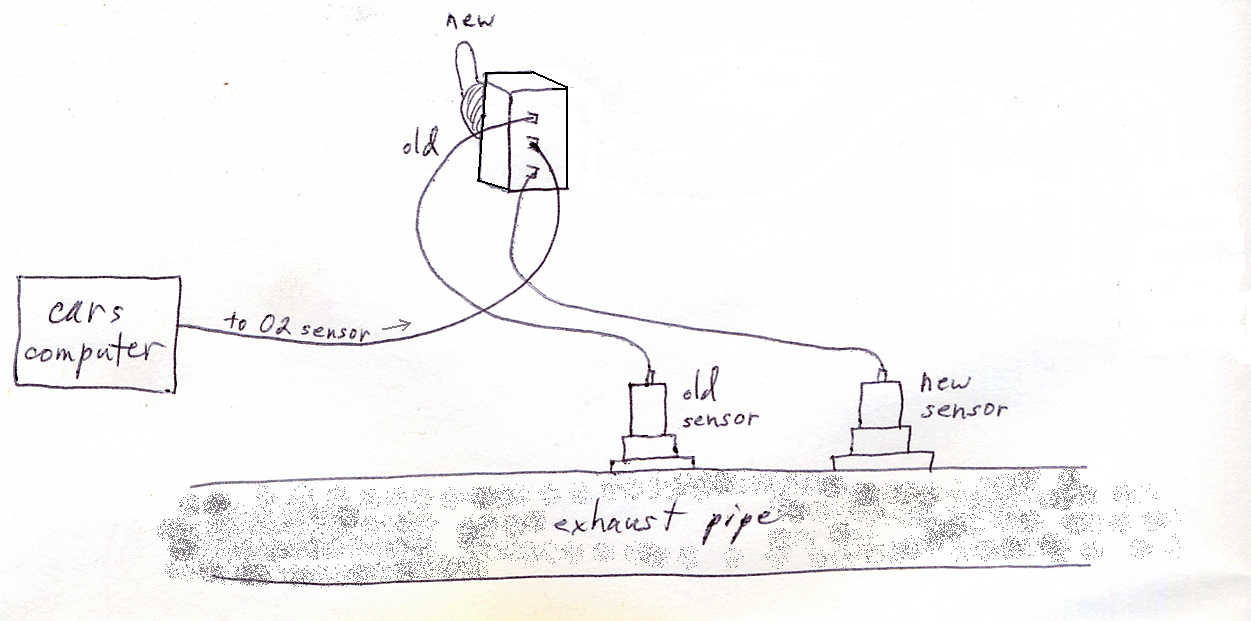

FOR CARBURETORS
For carburetor equipped cars it takes a modified version of the Carburetor Enhancer from Eagle Research. The unmodified kit provides gasoline leaning at idle, cruising, and deceleration but not during acceleration (which is ideal) but is only good up to 9% lean if you can't change the carburetors idle fuel mixture. One end of it tees into a vacuum line and the other end connects to an existing vent on the carburetor. But to get very lean air/fuel mixtures (>9% leaner) while cruising you need to open its valve so far that it also makes the idle mixture too lean and the engine may quit at idle. The RC-10 radio control box and solenoid air valve allows you to turn it on at will while driving instead of it being on all the time. That allows you to open the manual valve a lot so you'll get maximum fuel savings once you reach cruising speeds on the highway. (20-30% savings) But first you should see if you can change the idle fuel mixture. If you can then you should try to use the non-modified Carburetor Enhancer and open the valve during idle so that it idles roughly (to the point of almost dying), then adjust the idle fuel mixture screw for a richer idle mixture so that it idles smoothly again. Keep doing this until you have found the maximum cooperative point. Then go for a ride and see if it causes any problems (like dying when you slow down, misfiring, backfiring). If there are any problems then close the valve some, readjust the idle fuel mixture (favoring being "rich"), and do another test run.
If your carburetor doesn't allow idle mixture adjustment, or adjusting it throws off its equilibrium, then you'll definitely need the RC-10 radio controller and solenoid air valve. The solenoid air valve should interrupt the vacuum line going from the intake manifold to the manual air valve. This valve is not adjustable. When it is "on" it is completely open. The manual valve is the one that needs adjustment according to the cars needs.
Be sure to also order the manual for the Carburetor Enhancer because it shows where to hook it up to many different carburetors.

#1 is the RC-10. #2 is the solenoid air valve. #3 is the adjustable
manual air valve that comes with the Carburetor Enhancer.
RC-10 includes the transmitter.

The radio controlled switch, RC-10, (which includes two transmitters) are available for $18.75 from All Electronics. You'll need to solder the two indicated wires, or strip and crimp them. If you solder them (the best for lasting long, especially in humid climates) you'll need their 30 watt soldering iron # IR-30 for $4.50, solder # TS-110 for $1.25, and $1.35 1/8" diameter heat shrink tubing # HUG-18W. (Cut off two 1/4" long sections of tubing, put them on the black and white receiver wires, solder the wires together as shown in the drawing, then slide the tubing over the solder areas and cause it to shrink protect them by heating the tubing with the soldering iron.) You'll also need two ring terminals to crimp onto the ends of the red and black wires (for + and - voltage) which can be had (50 of them) for $3.25 as item # 82516. 50 crimp connectors are available for $2.50 as item # 5100. The wires can have their insulation stripped back by using a sharp knife, and the connectors can be clamped onto the bare wire ends with a good pair of pliers. The red receiver wire can be connected to the positive car battery post, or better yet to the positive high voltage ignition coil post so that it is only powered when the ignition switch is on.
FOR FUEL INJECTION SYSTEMS
For Fuel injected cars I recommend a computer-programmable wide band oxygen sensor (the LC-1) made by Innovate Motorsports. With it you can lean the air/fuel mixture down as far as 22:1 which is using 33% less gasoline. It will need to be installed in the exhaust pipe close to the existing sensor and you'll need to be able to manually or automatically select which one is connected to the cars computer. For manual control a switch will need to be wired to the two so that you can select which one the car will use. For automatic control you can use the RC-10 with a DPDT relay (All Electronics # RLY-497 $1.35). The manual switch (available from Radio Shack as part # 275-666 for $2.99) or automatic relay needs to be a double-pole-double-throw (DPDT) so that the second pole can energize or kill the power to the hydrolyser (if you're using one) which needs to be on only when the new oxygen sensor is in use. The LC-1 costs $200. If you only replaced the existing sensor with the programmable one then you wouldn't be able to use very lean mixtures without making the idle mixture too lean. The oxygen sensor controls the air/fuel ratio at all rpm's except when accelerating and when the engine is cold and warming up.
The LC-1 is pictured here:

